|
Featured picture tools: |
These featured pictures, as scheduled below, appeared as the picture of the day (POTD) on the English Wikipedia's Main Page in November 2019. Individual sections for each day on this page can be linked to with the day number as the anchor name (e.g. [[Wikipedia:Picture of the day/November 2019#1]] for November 1).
You can add an automatically updating POTD template to your user page using {{Pic of the day}} (version with blurb) or {{POTD}} (version without blurb). For instructions on how to make custom POTD layouts, see Wikipedia:Picture of the day.
November 1

|
The human skull is the bony structure that forms the head in the human skeleton. It supports the structures of the face and forms a cavity for the brain. Like the skulls of other vertebrates, it protects the brain from injury. The skull consists of three parts, of different embryological origin – the neurocranium, the sutures, and the facial skeleton (also called the membranous viscerocranium). The neurocranium (or braincase) forms the protective bony structure that surrounds and houses the brain and brainstem. The sutures are fairly rigid joints between bones of the neurocranium. The upper areas of the cranial bones form the calvaria (skullcap), whereas the facial skeleton is formed by the bones supporting the face, including the mandible. This picture is a diagram of the human skull as seen from the left, showing the main bones of the neurocranium and the facial skeleton. Diagram credit: Mariana Ruiz Villarreal
Recently featured:
|
November 2
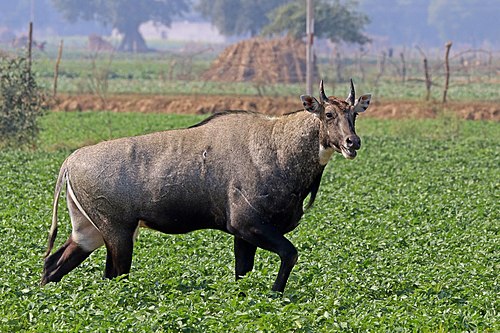
|
|
The nilgai or blue bull (Boselaphus tragocamelus) is the largest Asian antelope and is endemic to the Indian subcontinent. The sole member of the genus Boselaphus, the species was described and given its binomial name by German zoologist Peter Simon Pallas in 1766. The nilgai stands 1–1.5 metres (3.3–4.9 ft) at the shoulder; males weigh 109–288 kilograms (240–635 lb), and the lighter females 100–213 kilograms (220–470 lb). A sturdy thin-legged antelope, the nilgai is characterised by a sloping back, a deep neck with a white patch on the throat, a short crest of hair along the neck terminating in a tuft, and white facial spots. A column of pendant coarse hair hangs from the dewlap ridge below the white patch. Sexual dimorphism is prominent – while females and juveniles are orange to tawny, adult males have a bluish-grey coat. Only males possess horns, which are 15–24 centimetres (5.9–9.4 in) in length. This picture shows a male nilgai in a potato field at Jamtra, in the Indian state of Madhya Pradesh. Photograph credit: Charles J. Sharp
Recently featured:
|
November 3
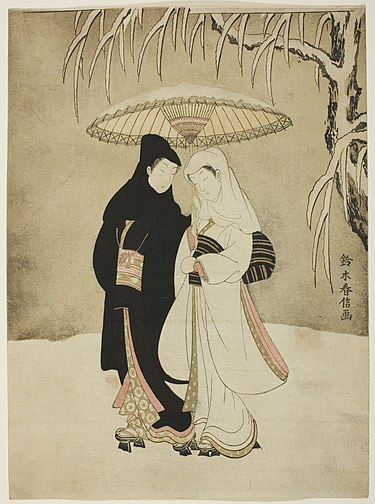
|
Ukiyo-e is a genre of Japanese art which flourished from the 17th through 19th centuries. Its artists produced woodblock prints and paintings of such subjects as female beauties; kabuki actors and sumo wrestlers; scenes from history and folk tales; travel scenes and landscapes; flora and fauna; and erotica. The term ukiyo-e translates as 'picture[s] of the floating world'. This picture is a colour woodblock print (chūban) entitled Two Lovers Beneath an Umbrella in the Snow, produced by ukiyo-e artist Suzuki Harunobu around 1767 and now in the collection of the Art Institute of Chicago. His delicate, romantic prints were amongst the first to realize expressive and complex colour designs, printed with up to a dozen separate blocks to handle the different colours and half-tones. His restrained, graceful prints invoked the classicism of waka poetry and Yamato-e painting. The prolific Harunobu was the dominant ukiyo-e artist of his time. The success of his colourful nishiki-e from 1765 on led to a steep decline in demand for the limited palettes of benizuri-e and urushi-e, as well as hand-coloured prints. Print credit: Suzuki Harunobu
Recently featured:
|
November 4

|
Rear Admiral Christopher Raymond Perry Rodgers (November 4, 1819 – January 8, 1892) was an officer in the United States Navy. He served in the Mexican–American War and the American Civil War, and also as Superintendent of the Naval Academy, President of the United States Naval Institute, and Commander-in-Chief of the Pacific Squadron. Rodgers was appointed midshipman in 1833 and served in the Pacific Squadron and at the New York Navy Yard, later taking part in operations in the Second Seminole War from 1839 to 1840. He was assigned to the Home Squadron in 1847 to serve in the Mexican–American War; he participated in the Siege of Veracruz in March, and in the capture of Tabasco and Tuxpan by his uncle Commodore Matthew C. Perry. In 1859, Rodgers was appointed Commandant of Midshipmen at the Naval Academy, serving there until the start of the Civil War in 1861, in which he saw action at the Battle of Port Royal and the Siege of Fort Pulaski. After the war, he served as Chief of the Bureau of Yards and Docks from 1871 to 1874 and later as Superintendent of the Naval Academy until 1878, before a two-year tour as Commander of the Pacific Squadron and returning to the Naval Academy as superintendent in 1881, retiring in November of that year. This picture of Rodgers was taken sometime between 1860 and 1865, during the Civil War, and is in the collection of the Library of Congress in Washington, D.C. Photograph: unknown; restored by Eddie891
Recently featured:
|
November 5
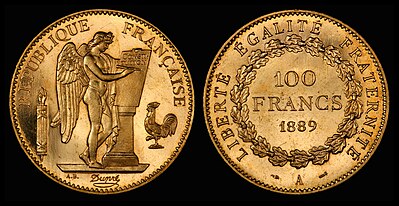
|
The French franc is a former currency of France and Monaco and, alongside the Spanish peseta, a former de facto currency in Andorra. The first franc was a gold coin introduced in 1360, which showed King John II of France on a richly decorated horse, earning it the name franc à cheval. A later coin, showing Charles VII on foot, under a canopy, was named the franc à pied. The decimal franc was established by the French Revolutionary Convention in 1795 as a decimal unit, and became the official currency of France in 1799. France joined the euro in 1999, and the franc was replaced by euro notes and coins in 2002. This picture shows a 100-franc gold coin, dated 1889, with a "winged genius" designed by Augustin Dupré on the obverse. Only a hundred proof coins of this design were minted. Coin credit: Monnaie de Paris; photographed by the National Numismatic Collection
Recently featured:
|
November 6

|
The Academy of Athens is Greece's national academy and the highest research establishment in the country. Established on 18 March 1926, it operates under the supervision of the Ministry of Education and Religious Affairs. This picture shows the main building of the Academy, a neoclassical building between Panepistimiou Street and Akadimias Street in the centre of Athens and one of the city's major landmarks. The building was designed as part of an architectural "trilogy" in 1859 by Danish architect Theophil Hansen, along with the University and the National Library. The Greek neoclassical sculptor Leonidas Drosis sculpted the principal multi-figure pediment sculpture, on the theme of the birth of Athena, based on a design by painter Carl Rahl. Two columns on either side of the portico feature statues of Athena on the left and Apollo on the right, also designed by Drosis. Photograph credit: Thomas Wolf
Recently featured:
|
November 7

|
|
The Pool of Bethesda was a pool of water in the Muslim Quarter of Jerusalem, on the path of the Beth Zeta Valley. It is known from the New Testament story of healing the paralytic at Bethesda, from the fifth chapter of the Gospel of John; the gospel describes a pool in Jerusalem, near the Sheep Gate, which is surrounded by five covered colonnades. Until the 19th century, there was no evidence outside of John's gospel for the existence of this pool; therefore, scholars argued that the gospel was written later, probably by someone without first-hand knowledge of the city of Jerusalem, and that the pool had only a metaphorical, rather than historical, significance. In the 19th century, archaeologists discovered the remains of a pool fitting the description in the gospel. This picture is an 1877 oil-on-canvas painting of the Pool of Bethesda by English painter Robert Bateman, now in the collection of the Yale Center for British Art in New Haven, Connecticut. The Johannine narrative describes the porticos as being a place in which large numbers of infirm people were waiting, which corresponds well with the site's 1st century AD use as an asclepeion. Some ancient biblical manuscripts argue that these people were waiting for the troubling of the water; a few such manuscripts also move the setting away from Roman rituals into something more appropriate to Judaism, by adding that an angel would occasionally stir the waters, which would then cure the first person to enter. Painting credit: Robert Bateman
Recently featured:
|
November 8

|
The Montana Territory was an organized incorporated territory of the United States that existed from May 26, 1864, when it was split from the Idaho Territory, until November 8, 1889, when it was admitted as the 41st state in the Union as the state of Montana. The capitals of the territory were Bannack (1864–1865), Virginia City (1865–1875) and Helena (1875–1889). This picture is a historical depiction of the Montana Territory's coat of arms, as illustrated by American engraver Henry Mitchell in State Arms of the Union, published in 1876 by Louis Prang. The shield depicts a landscape of mountains, plains and forests by the Great Falls of the Missouri River. A plow, a pick and a shovel are depicted in the foreground, representing the territory's industries. Below the shield is the Spanish motto Oro y plata, meaning 'Gold and silver'. The same design is featured in the current seal of Montana. Illustration credit: Henry Mitchell; restored by Andrew Shiva
Recently featured:
|
November 9

|
The greater kudu (Tragelaphus strepsiceros) is a species of woodland antelope in the genus Tragelaphus found throughout eastern and southern Africa. Despite occupying widespread territory, they are sparsely populated in most areas due to declining habitat, deforestation and poaching. The greater kudu is one of two species commonly known as kudu, the other being the lesser kudu, T. imberbis. Greater kudus have a narrow body with long legs, and their coats can range from brown or bluish grey to reddish brown. They possess between four and twelve vertical white stripes along their torso. The head tends to be darker in colour than the rest of the body, and exhibits a small white chevron running between the eyes. The helical horns of adult males grow as the animal ages, reaching 2+1⁄2 rotations at about 6 years old. This picture shows a greater kudu bull photographed near Groot Okevi in Etosha National Park, Namibia. Bulls weigh 190–270 kg (420–600 lb), up to a maximum of 315 kg (690 lb), and stand up to 160 cm (63 in) tall at the shoulder. Photograph credit: Hans Hillewaert
Recently featured:
|
November 10

|
Les Grandes Baigneuses ('The Large Bathers') is an oil-on-canvas painting by French artist Pierre-Auguste Renoir, produced between 1884 and 1887. The painting depicts a scene of nude women bathing. In the foreground, two women are seated beside the water, and a third is standing in the water near them. In the background, two others are bathing. Renoir's intention was to reconcile the modern forms of painting with the painting traditions of the 17th and 18th centuries, particularly those of Ingres and Raphael. The painting is now in the collection of the Philadelphia Museum of Art. Painting credit: Pierre-Auguste Renoir
Recently featured:
|
November 11

|
Ermina Zaenah (born 11 November 1928) is an Indonesian actress and film producer active in the 1950s and 1960s. Born in Jambi, she completed her elementary school education before pursuing a career in entertainment, acting in stage plays. Zaenah led a musical group, the Los Suita Rama, and performed topeng dance. In 1951 Zaenah entered the film industry, performing in productions by Tan and Wong Bros and Golden Arrow, and Fred Young's Bintang Surabaya. She later migrated to Djamaluddin Malik's Persari, starring in several films for the company, including Supir Istimewa. Zaenah moved behind the camera in the 1960s, working as producer on four films, Kamar 13 ('Room 13'), Lagu dan Buku ('Song and Book'), Bakti ('Service'), and Ekspedisi Terakhir ('The Last Expedition'). She later returned to the theater for a short time when she toured Java with the group Sapta Daya. During her fourteen-year career in the entertainment industry, Zaenah acted in thirty films. This picture is a three-quarter portrait of Zaenah from a postcard, taken around 1960 and printed on silk-finish paper. Photograph credit: unknown; restored by Chris Woodrich
Recently featured:
|
November 12

|
Portsmouth Cathedral, officially known as the Cathedral Church of St Thomas of Canterbury, is an Anglican cathedral church in Portsmouth, England. It is the cathedral of the Diocese of Portsmouth and the seat of the bishop of Portsmouth. The cruciform building was constructed in the Romanesque style on land donated by Norman lord Jean de Gisors in the 1180s and dedicated to Saint Thomas Becket, who was martyred around ten years earlier. It was made a cathedral upon the establishment of the Diocese of Portsmouth, which was split from the Diocese of Winchester in 1927, after which it was extended in a "Neo-Byzantine" style by Charles Nicholson. This picture shows the cathedral's quire, built in a classical style in the late 17th century, looking northeastwards towards the apse. Photograph credit: David Iliff
Recently featured:
|
November 13

|
HR 8799 is a roughly 30-million-year-old main-sequence star located 129 light-years (39.6 parsecs) away from Earth in the constellation of Pegasus. It has roughly 1.5 times the Sun's mass and 4.9 times its luminosity, and is part of a system that also contains a debris disk and at least four massive planets. Those planets, along with Fomalhaut b, were the first exoplanets whose orbital motion was confirmed via direct imaging. The star is a Gamma Doradus variable: its luminosity changes because of non-radial pulsations of its surface. It is also classified as a Lambda Boötis star, which means its surface layers are depleted in iron peak elements. This video shows the HR 8799 planetary system across a period of seven years, with motion interpolation used on seven images captured between 2009 and 2016 by the W. M. Keck Observatory in Hawaii. The light from the star, in the center, is obscured to allow the four orbiting planets to be seen. From innermost to outermost, the planets are designated e (center right), d (bottom right), c (top right), and b (top left). Video credit: Jason Wang et al.; edited by Benjamin Hunt and Jan-Eric Nyström
Recently featured:
|
November 14

|
The Iranian toman is a superunit of the official currency of Iran, the rial. One toman is equivalent to ten rials. Although the rial is the official currency, Iranians use the toman in everyday life. Originally, the toman consisted of 10,000 dinars. Between 1798 and 1825, the toman was also subdivided into eight rials, each of 1,250 dinars. In 1825, the qiran was introduced, worth 1,000 dinars or one-tenth of a toman. This picture shows a one-toman banknote issued by the Imperial Bank of Persia, dated 1906. The note was produced by English printers Bradbury Wilkinson and Company and depicts Naser al-Din, shah of the Qajar dynasty, on the obverse (top). Banknote credit: Bradbury Wilkinson and Company; photographed by Andrew Shiva
Recently featured:
|
November 15
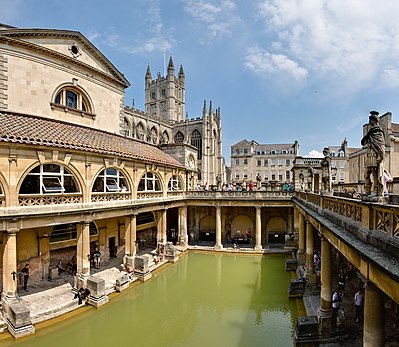
|
The Roman Baths complex is a site of historical interest in the English city of Bath, Somerset. It is a well-preserved site dating from Roman Britain once used for public bathing. The Roman baths themselves are below the modern street level. There are four main features: the Sacred Spring, the Roman Temple, the Roman Bath House, and the museum which holds finds from the Roman town. The buildings above street level date from the 19th century. The Baths are a major tourist attraction and, together with the Grand Pump Room, received more than 1.3 million visitors in 2018. Visitors can tour the baths and museum but cannot enter the water. This picture shows the Great Bath of the Roman Baths complex, with Bath Abbey visible in the background. The entire structure above the level of the pillar bases is of later construction. Photograph credit: David Iliff
Recently featured:
|
November 16

|
Helleborus orientalis, also known as the Lenten rose, is a perennial flowering plant and a species of hellebore in the buttercup family, Ranunculaceae, native to Greece and Turkey. Jean-Baptiste Lamarck described the species in 1789, giving it its current name of Helleborus orientalis ("Hellébore du Levant"). The species name is derived from the Latin oriens ('east'). The common name derives from the plant's flowering during Lent. Within the genus Helleborus, it has been classified in the section Helleborastrum, and is closely related to the other eight species in the section. These species are all highly variable and hybridise with each other freely. This picture shows an H. orientalis flower from the Netherlands, showing swollen seedpods. Photograph credit: Dominicus Johannes Bergsma
Recently featured:
|
November 17

|
"William" is the nickname of a faience hippopotamus statuette from the Middle Kingdom of Egypt, now in the collection of the Metropolitan Museum of Art in New York City, where it serves as an informal mascot of the museum. Found in a shaft associated with the Upper Egyptian tomb chapel of "The Steward, Senbi", in what is now Meir, William dates from c. 1961 BC – c. 1878 BC during the reigns of Senusret I and Senusret II. This small figurine in Egyptian faience, a clay-less material, has become popular not only for his endearing appearance but also because his defining characteristics illustrate many of the most salient facets of craft production in ancient Egypt during this time. Sculpture credit: unknown; photographed by the Metropolitan Museum of Art
Recently featured:
|
November 18

|
Enclosed Field with Peasant is an oil-on-canvas painting by Dutch artist Vincent van Gogh, painted in October 1889. The painting was created during one of the most tumultuous parts of Van Gogh's life, after he voluntarily committed himself to an asylum in Saint-Rémy in southern France. He was recuperating from a nervous breakdown he suffered on Christmas Eve in 1888, during a visit with fellow post-impressionist artist Paul Gauguin. The painting is now in the collection of the Indianapolis Museum of Art in the U.S. state of Indiana. Painting credit: Vincent van Gogh
Recently featured:
|
November 19
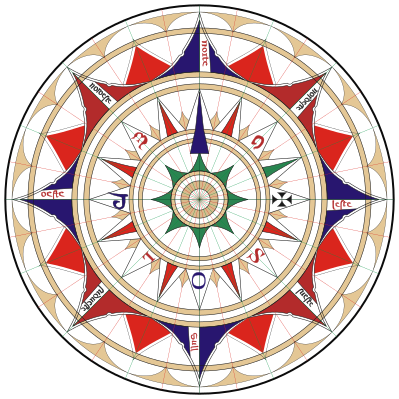
|
A compass rose, sometimes called a windrose or rose of the winds, is a figure on a compass, map, nautical chart, or monument used to display the orientation of the cardinal directions (north, east, south, and west) and their intermediate points. It is also the term for the graduated markings found on the traditional magnetic compass. Today, a form of compass rose is found on, or featured in, almost all navigation systems, including nautical charts, non-directional beacons, VHF omnidirectional range systems, GPS, and similar equipment. This picture is an illustration of a compass rose, copied from a 1492 portolan chart by Portuguese navigator and cartographer Jorge de Aguiar, now in the Beinecke Rare Book & Manuscript Library. Illustration credit: Joaquim Alves Gaspar, after Jorge de Aguiar
Recently featured:
|
November 20

|
Profile Portrait of a Young Lady is a 1465 half-length portrait in oil on poplar, commonly attributed to Italian artist Antonio del Pollaiuolo. A minority of scholars attribute the portrait to another Italian artist, Piero della Francesca. Wilhelm von Bode attributed the painting to Domenico Veneziano; it has also been alternatively attributed to Alesso Baldovinetti. The emphatic use of line and the clarity of the contrasting colour surfaces in the work are typical features of the Florentine School. The anonymous woman is depicted in a brocade dress, with her posture suggesting that she is sitting in the marble embrasure of a window or balcony. The painting is now in the collection of the Gemäldegalerie, Berlin. Painting credit: Antonio del Pollaiuolo (attributed)
Recently featured:
|
November 21

|
North Carolina is a state in the Southeastern United States, the 28th largest and 9th most populous of the fifty states. Raleigh is the state's capital and Charlotte is its largest city. North Carolina was established as a royal colony in 1729 and is one of the original Thirteen Colonies. The state is named in honor of King Charles I of England, who first formed the English colony, with Carolus being Latin for 'Charles'. On November 21, 1789, North Carolina became the 12th state to ratify the United States constitution. This picture is a historical depiction of North Carolina's coat of arms, as illustrated by American engraver Henry Mitchell in State Arms of the Union, published in 1876 by Louis Prang. The shield depicts personifications of Liberty on the left and Plenty on the right. Liberty holds a liberty pole in her left hand and a scroll with the word "Constitution" in her right hand, while Plenty holds the end of a cornucopia next to her in her left hand and three heads of wheat in her right hand, extended towards Liberty. A similar design is featured in the current seal of North Carolina. Illustration credit: Henry Mitchell; restored by Andrew Shiva
Recently featured:
|
November 22

|
Guion Bluford (born November 22, 1942) is an American aerospace engineer, retired U.S. Air Force officer and fighter pilot, and former NASA astronaut, who is the first African American and the second person of African descent to go to space. Before becoming an astronaut in 1978 as part of NASA Astronaut Group 8, Bluford was an officer in the U.S. Air Force, where he remained while assigned to NASA, rising to the rank of colonel. He participated in four Space Shuttle flights between 1983 and 1992. In 1983, as a member of the crew of the Space Shuttle Challenger on the mission STS-8, he became the first African American in space, as well as the second person of African ancestry in space, after Cuban cosmonaut Arnaldo Tamayo Méndez. This picture of Bluford is his official NASA portrait, taken in 1992, the year of his final mission, STS-53. He is depicted in his Launch Entry Suit and holding the helmet. Photograph credit: NASA; retouched by Coffeeandcrumbs
Recently featured:
|
November 23

|
The crested myna (Acridotheres cristatellus), also known as the Chinese starling, is a species of starling in the genus Acridotheres native to southeastern China and Indochina. It is named after the tuft of feathers on its forehead that resembles a crest. The crested myna is typically found in open spaces near urban and agricultural areas. It is a popular cage-bird and, as a result, has been accidentally released in a few places outside of its usual range. For example, this species was introduced around 1890 into the Vancouver region of British Columbia, Canada. Like many starlings, the crested myna is omnivorous. It will eat a variety of food including worms, grub, grains, fruit, and even garbage. It is a highly beneficial bird to farmers as it predates on insects and does not attack crops. This picture shows a crested myna photographed in Osaka, Japan. Photograph credit: Laitche
Recently featured:
|
November 24

|
Tarring and feathering is a form of public torture and humiliation used to enforce unofficial justice or revenge. It was used in feudal Europe and its colonies in the early modern period, as well as the early American frontier, mostly as a type of mob vengeance. The victim would be stripped naked, or stripped to the waist. Hot wood tar was then either poured or painted onto the person while they were immobilized. The victim then either had feathers thrown on them or was rolled around on a pile of feathers so that they stuck to the tar. The image of a tarred-and-feathered outlaw remains a metaphor for severe public criticism. This picture shows German-American farmer John Meints, of Luverne, Minnesota, who was tarred and feathered in August 1918 for allegedly not supporting war bond drives during World War I. The photograph is in the collection of the National Archives and Records Administration. Photograph credit: unknown; restored by Opencooper
Recently featured:
|
November 25

|
A. Hamid Arief (25 November 1924 – 20 December 1992) was an Indonesian actor who appeared in over 120 films. He started his acting career in live theatre before migrating to film in 1948, and gaining widespread recognition in 1953 with his first starring role. He is seen here in a promotional still taken around 1960. He was a prolific performer, appearing in over sixty films in the 1970s and taking part in a number of television series. Photograph credit: Tati Photo Studio; restored by Chris Woodrich
Recently featured:
|
November 26
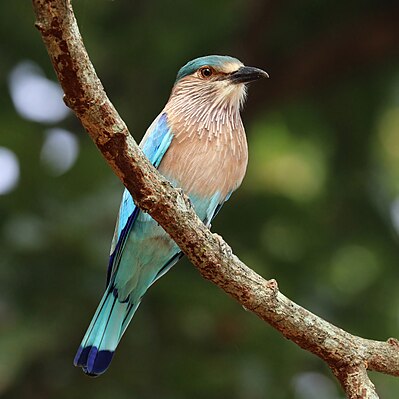
|
The Indian roller (Coracias benghalensis) is a member of the bird family Coraciidae, the rollers. It occurs widely from the Arabian Peninsula to the Indian subcontinent and is designated as Least Concern on the IUCN Red List. The bird is best known for the aerobatic displays of males during the breeding season. It is commonly found in open grassland and scrub forest habitats, and is often seen perched on roadside bare trees and wires, which give it a good view of the ground below where it finds its prey. Its diet consists mainly of insects such as beetles and grasshoppers, but also includes spiders, scorpions, amphibians and small reptiles. The largest population occurs in India, and several states in India have chosen it as their state bird. This picture shows an Indian roller of the benghalensis subspecies, photographed in Kanha Tiger Reserve in the Indian state of Madhya Pradesh. Photograph credit: Charles J. Sharp
Recently featured:
|
November 27

|
Neo-Impressionism is a term coined by French art critic Félix Fénéon in 1886 to describe an art movement founded by Georges Seurat, whose most renowned masterpiece, A Sunday Afternoon on the Island of La Grande Jatte, marked the beginning of this movement when it was first exhibited in Paris. Around this time, the peak of France's modern era emerged and many painters were in search of new methods. Followers of Neo-Impressionism, in particular, were drawn to modern urban scenes as well as landscapes and seashores. Science-based interpretation of lines and colors influenced Neo-Impressionists' characterization of their own contemporary art. The Pointillist and Divisionist techniques are often mentioned in this context, because it was the dominant technique in the beginning of the Neo-impressionist movement. This picture is a oil-on-canvas portrait of Félix Fénéon in the Neo-Impressionist style by French painter Paul Signac, dated 1890. The painting is now in the collection of the Museum of Modern Art in New York City. Painting credit: Paul Signac
Recently featured:
|
November 28

|
Lichfield Cathedral is an Anglican cathedral in Lichfield, in the English county of Staffordshire. A cathedral was first built on the site in 700, by Bishop Headda, to house the bones of St Chad. The original wooden building was replaced by a Norman cathedral made from stone, which in turn was replaced by the present Gothic structure, begun in 1195. The fabric of the cathedral suffered in the English Civil War, when it was used as a defensive structure. In the 18th century the interior was extensively remodelled, with major structural work organised by James Wyatt; this involved removing the high altar to make a single worship area consisting of the choir and lady chapel, and adding a massive stone screen at the entrance to the choir. This picture shows the interior of Lichfield Cathedral as seen from the choir, with the cathedral's high altar in the centre. Photograph credit: David Iliff
Recently featured:
|
November 29

|
Mitra stictica, commonly known as the pontifical mitre, is a species of sea snail, a marine gastropod mollusc in the family Mitridae. This species is found in the tropical Indian and Pacific Oceans and may reach 87 mm (3.4 in) in length. Mitre shells are so-called because their shape resembles that of a mitre, the ceremonial head-dress of bishops in the Christian church. They are predators, using a long toothed radula to feed on worms and molluscs. This picture shows five views of an empty M. stictica shell from Queensland, Australia, some 6 cm (2.4 in) long. Clockwise from top left, the shell is seen in abapertural, lateral, apertural, umbilical, and apical views. Photograph credit: H. Zell
Recently featured:
|
November 30

|
Miss La La at the Cirque Fernando is an 1879 oil-on-canvas painting by French Impressionist artist Edgar Degas. The mixed-race acrobat caused a sensation when she performed at the Cirque Fernando in Montmartre, Paris. In this painting, she is shown suspended from the rafters of the circus dome by a rope clenched between her teeth. Degas sought out such striking modern subjects, concentrating on figures in arresting poses; he may have also been seeking to emulate paintings by Italian artists such as Tiepolo in painting a highly foreshortened figure. In January 1879, he made a series of drawings at the Cirque Fernando, including a pastel study of Miss La La, now in the Tate's collection, which culminated in this painting. The viewer sees the spectacle as the audience would have done, gazing up at the daring feat taking place above. The painting is now in the collection of the National Gallery in London. Painting credit: Edgar Degas
Recently featured:
|
Picture of the day archives and future dates